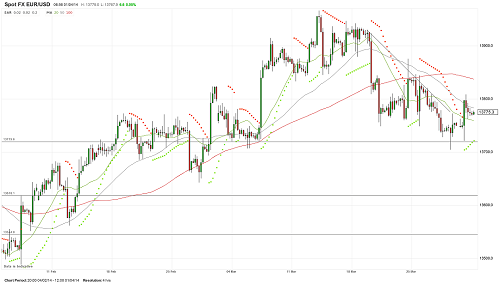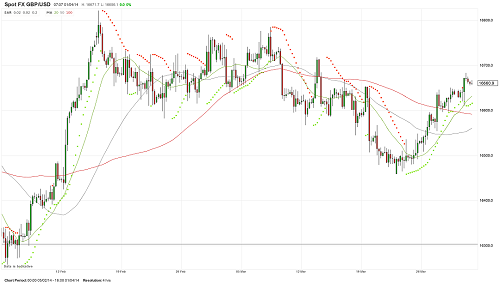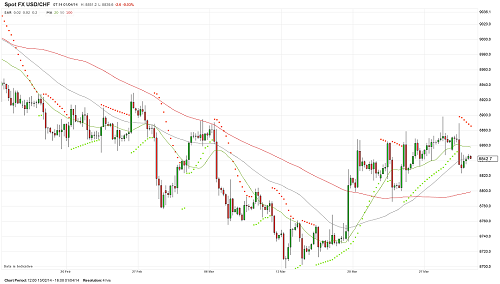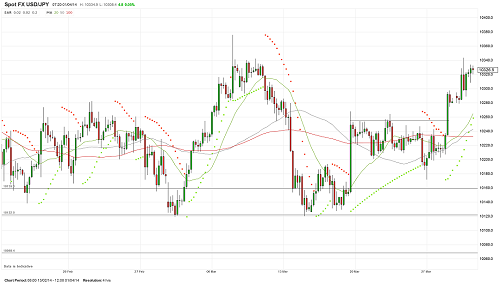Source: Brian Sylvester of The Mining Report (4/1/14)
http://www.theaureport.com/pub/na/no-title-15924
Stephan Bogner, mining analyst with Rockstone Research and CEO of Elementum International, views the crisis in Crimea as the beginning of a larger global power shift east of the Atlantic. In this interview with The Mining Report, Bogner details what these shifting power dynamics will mean for the commodities market. And take heed—gold and silver may continue to make gains, but uranium, potash and rare earths are the true wave of the future.
The Mining Report: In his recent interview with The Gold Report, Robert Cohen said that now that Crimea has joined Russia, the crisis in Ukraine has run its course, which is why the price of gold has dropped. As a European mining analyst, do you agree with Cohen’s assertion?
Stephan Bogner: In my view, high-level Wall Street players are orchestrating the gold price drop as a means of making people believe everything is in order again. They’re attempting to convey that the crisis premium has been deducted from the gold price after its rise in the wake of the Crimea crisis, but I wouldn’t bet on that.
Remember when gold rose from $300/ounce ($300/oz) to almost $400/oz in 2002-2003 due to the widely propagated Iraq War premium? When the war was over in early 2003, the price fell back to $320/oz. People used the same argument then: the gold price is dropping because the crisis is over. In a few months, the price rose to $500/oz for no reason the experts could explain.
Don’t bet on TV experts and commentaries. Bet on your gut feeling, especially when it’s getting quiet and experts are going silent.
TMR: What is the general sentiment among the Germans regarding the situation in Ukraine?
SB: According to large polls in Germany, most Germans think that not only Russia, but the Ukrainian government, the EU and the U.S. all have made mistakes and share the blame, and that the crisis is not our business and we shouldn’t get too involved. One out of two Germans thinks that we should only use diplomatic measures and only every fourth German thinks that sanctions against Russia would be appropriate. That said, I doubt most Germans know what the full consequences that sanctions against Russia would bring us.
TMR: It seems the west is unwilling to do much to help Ukraine, apart from sanctions against Russia. Is this emblematic of a power shift from west to east?
SB: According to these polls, 75% of Germans distrust Putin and at the same time think that he is “clever and strong”, but more than 60% of Germans doubt that Obama can solve this conflict. The traditional thinking that sees Russia as mainly negative and the U.S. as mainly positive is breaking apart. The NSA scandal and George W. Bush laid the foundation for the anti-American impulses that are on the sharp rise again. Vladimir Putin’s power and influence have shifted the balance of power from west to east, although we are too proud to fully admit that.
European politicians should know that sanctions against Russia would be useless and counterproductive, to say the least. Germany and especially other European countries are far too dependent on Russian gas supplies and other commodities to threaten Russia with sanctions. We must acknowledge our fault in deciding to abandon all nuclear power plants in Germany, as we are now paying the price for our energy dependence. Putin must be doubling over with laughter about the proposed sanctions, because he’s smart enough to understand that the threat of sanctions is merely chest-beating, as we attempt to convince our own citizens that we still have some influence.
Europe should try to get on the same page with Russia. I believe this can evolve to be a good thing, as Europe and Russia can become a happy new superpower, especially as we partner more with China. I rather want to see Europe team up with Russia and China to replace U.S. dollar-based transactions with what I envision as a gold-backed monetary system.
Russia can benefit immensely being strategically positioned in the heart of both and sitting on vast amounts of natural resources that can be fed to Europe and China. Ultimately, I see Russian, European and Chinese economies flourishing, while the U.S. inflates itself and becomes dependent on this new superpower.
I believe that Russia will successfully merge with Ukraine. I also believe that this crisis was the beginning of currency and commodity wars that may escalate. After years of depreciating commodity and gold prices, during which the smart accumulated as much as possible, the tide is turning and higher prices are on the forefront.
TMR: How will an alliance of this magnitude and the prospect of currency and commodity wars impact the U.S. economy?
SB: Russia may already be quietly backing away from the dollar. In late 2013, Russia held some $138 billion ($138B) in U.S. treasuries—a fair amount, yet dwarfed by the more than $1 trillion in reserves held by both China and Japan.
Russia is not in a position to take down the U.S. bond market on its own, yet it may have a significant impact when it decides to sell. Russia will have good reason to sell U.S. debt and U.S. stocks, and possibly pursue other means of impacting the globalized capital markets, if the U.S. continues to act so aggressively. Sales by Russia also could trigger others into selling. If the U.S. imposes sanctions against Russia, Chinese officials may start to get the notion that they are too dependent on the dollar, which could lead China to sell U.S. treasuries.
On the other hand, it would be good for the U.S. in the long run if foreign countries dumped their U.S. treasuries and turned away from the dollar. The U.S. economy is too dependent on foreigners buying its debt. I am certain that Russia, and maybe China, are already reducing their exposure to U.S. debt and are ready to shoot back aggressively with massive selloffs if the U.S. goes far out on a limb. This would bring about a falling dollar and a rising gold price. I would rather bet on that than anything else.
TMR: And how will that affect the price of gold?
SB: In the short term, the gold price can fall due to manipulation, but in the mid- to long-term, betting on gold is a sure thing because Russia and China are betting on gold as well. They both know that the fiat system hates gold and they know that once the gold market has dried up or if the U.S. threatens them, they can let the gold price explode.
TMR: Iraq bought 36 metric tons of gold recently, valued at $1.6B, the biggest gold purchase by a sovereign power in three years. Is this part of the shift that you are talking about?
SB: Yes, I believe so.
TMR: After a strong start this year, the gold price is seeing diminishing support above $1,300/oz. Is the bull simply resting or has the bear returned? What would you say to an investor who is still uneasy after a three-year bear market in gold equities and to a lesser extent gold itself?
SB: I would say don’t worry. Be happy with gold and silver. Their times will come, as certainly as there is an “amen” at church.
TMR: Where is gold safer, in your mattress or in cash in the bank?
SB: That is the question that high-level players on Wall Street want you to think about. The orchestrated bear market has become a self-fulfilling prophecy, with China and Russia probably also manipulating the gold price to the downside as they are all purchasing from people who are asking themselves this question—people who are selling or are no longer buying.
In the end, only the brave will be among the winners—those who never doubted that such a question is nothing but a trap to steal your gold and silver and attempt to force a bear market.
TMR: Which gold and precious metals equities are you following at Rockstone Research?
SB: I like Klondex Mines Ltd. (KDX:TSX; KLNDF:OTCBB), because it was able to acquire the Midas mine and mill from Newmont Mining Corp. (NEM:NYSE). This gives Klondex a competitive edge in Nevada that the market has not yet fully understood. The company’s management team is among the best in the entire industry and I expect a steady increase in output from now on.
You want to hold high-grade gold in your portfolio in difficult market times. Nevada is the best place in the world to explore and mine for gold. That is also why I like Gold Standard Ventures Corp. (GSV:TSX.V; GSV:NYSE). Dave Mathewson, the former Newmont chief geologist, knows that there are elephant-sized gold deposits—in excess of 20 million ounces (20 Moz)—on the company’s district-sized property. The latest Pinion acquisition adds tremendous size and potential for large gold deposits to be discovered in the next months and years.
Keep NOVAGOLD (NG:TSX; NG:NYSE.MKT) on your radar as well. Once gold prices pick up, this company will be ready to either advance its Donlin property into a mine or be taken out. I also highly recommend Columbus Gold Corp. (CGT:TSX.V) and have no doubt of its success. The management team is determined to bring this highly prospective deposit in production just when I anticipate gold prices will have recovered substantially. It’s all about timing and Columbus is one of the few gold development companies that is right on track.
I’m very bullish on gold and silver in general. However, these markets are among the most manipulated and thus are riskier, especially now, when it is unclear if the market is in recovery mode or if further selloffs may cause the gold price to fall to $1,000/oz. Nonetheless, I follow a few precious metals companies because I like them fundamentally.
TMR: What about silver equities?
SB: I admire IMPACT Silver Corp. (IPT:TSX.V) for having a management team that knows how to overcome the current depressed state of the market. It will prosper above average once markets have recovered.
The same applies to Santacruz Silver Mining Ltd. (SCZ:TSX.V; 1SZ:FSE). The company has brought Rosario into production with low capital expense (capex) and sound profit margins during bad market conditions, hence Santacruz will prosper nicely when silver prices are on the rise.
Golden Arrow Resources Corp. (GRG:TSX.V; GAC:FSE; GARWF:OTCPK) has already identified a silver resource greater than 100 Moz, and I’m positive that will increase.
But really, I’m far more bullish on uranium, potash and rare earths at the moment. To me, they have virtually no downside risk now and are more likely to rise from today’s rock bottom prices than gold and silver. For example, the entire junior- and senior-uranium market is anticipating the beginning of a strong upswing in uranium prices from the current rock-bottom level where it has been holding for quite some time now.
TMR: What is the case for uranium?
SB: I think uranium has one of the best outlooks of all commodity markets right now and my favorite explorer is Lakeland Resources Inc. (LK:TSX.V).
The Lakeland stock has more than doubled since December and other major uranium companies have been on the rise since late 2013 as well. Denison Mines Corp. (DML:TSX; DNN:NYSE.MKT) is up 30%. Cameco Corp. (CCO:TSX; CCJ:NYSE) is up 40%. Fission Uranium Corp. (FCU:TSX.V) is up 60%.
TMR: Isn’t this trend largely based on the Athabasca Basin area play and Fission’s success with a new type of uranium deposit there?
SB: Of course, Fission has more than tripled its stock price because of its discovery of an amazing deposit. The price increases for Denison, which isn’t successfully exploring anything, and for Cameco, a large senior mining company, demonstrates that the entire market is already anticipating a move up in uranium prices, I would argue.
TMR: Do you follow other uranium plays?
SB: I’m pretty much focused only on the Athabasca Basin. I wouldn’t want to look in any other jurisdiction than Canada for political and jurisdiction reasons.
I’m looking more at companies with the potential to become the next Fission. Lakeland, with its large portfolio and strategy of forging joint venture (JV) partnerships, is unparalleled in the Athabasca Basin. It will have one of the largest drilling programs in the entire Athabasca Basin in 2014.
TMR: Any other names you would like to mention?
SB: NovX21 Inc. (NOV:TSX.V) has patented a clean platinum group metals (PGM) recovery technology that can be implemented anywhere. The technology uses little energy and creates no pollution. It has a low capex, offers a quick payback and has a gross margin in excess of 30%.
In the U.S. and Canada alone, more than 12 million (12M) catalytic converters are recycled every year. Worldwide, there are some 50M used cars, but only half of their catalytic converters are recycled. Today, PGMs are usually recovered using capital-intensive smelters. These smelters employ a lot of energy to melt metals between 1,500–3,000 degrees Celsius, generating a lot of pollution.
The NovX21 pilot plant in Québec has been running in an outstanding manner for two years now, making this a great investment opportunity with limited risks. Its process will become the gold standard for PGM recycling.
TMR: Most investors consider rare earth elements (REE) an afterthought at this point. What are you seeing?
SB: The REE exploration and mining space is probably the most difficult commodity market for investors to understand. Yet, I believe that once the market understands how to evaluate an REE deposit, the few really promising REE stocks will appreciate in an outstanding manner. In December 2013, we published two articles on REEs, and named Commerce Resources Corp. (CCE:TSX.V; D7H:FSE; CMRZF:OTCQX) as our favorite in the REE space. That stock has more than doubled since December.
Most REE prices have already hit bottom and are beginning to recover. An upswing in market prices would lift many REE stocks strongly. However, there are few promising development projects and my research explains how to find them.
TMR: Does Commerce have the capital needed to be at the right stage once prices start to rebound?
SB: No, but it doesn’t need to, because it took out most of the risk already. It is in the prefeasibility stage. The company is looking for a partner that is capital-strong before it takes the next risks and brings the Ashram project into production. I have no doubt at all that Commerce will find a partner and that Ashram will be among the next development projects to be put into production.
TMR: Zimtu Capital Corp. (ZC:TSX.V) holds a significant position in Commerce. Will Zimtu be able to help Commerce get the money it needs to advance its projects?
SB: Well, Zimtu has been backing up Commerce with the right people ever since.
TMR: Zimtu is up about 40% year-to-date. Is there much upside left?
SB: Oh yes. Many of its core holdings have more than doubled year-to-date. For example, Commerce Resources has doubled and Western Potash Corp. (WPX:TSX.V) has more than doubled year-to-date.
Zimtu is one of my overall top picks if the mining market recovers. Its share ownership and diversified investment portfolio offer unparalleled upside to a wide variety of commodities, including potash, uranium, REEs, tantalum and niobium, copper, zinc, graphite and gold. The company consistently adds new positions and commodities through property transactions, as well as creating publicly listed companies. And Zimtu is probably the only publicly traded company in which investors can participate in the company-building process as it is a second-to-none prospect generator that is all about people.
Zimtu has been in this business for more than a decade and has established a reputation that is paying off now. Zimtu’s share structure is so tight, with only 11M shares in the market and no warrants outstanding, that its stock is poised to move up in an unparalleled fashion. Management has been very diligent in structuring this company and its shareholder base. I believe that its stock will thrive once the market understands that Zimtu is not only about its core investment holdings but more about future transactions as that is where tremendous value is created and when shareholder value is maximized as no other company in the resource space is capable of doing such on a regular basis.
Zimtu has share holdings in more than 40 publicly traded companies and numerous private companies that are on the verge of going public. Kapuskasing Gold Corp. (OLA:TSX.V) is a good recent example. Zimtu already holds some 2.5M shares and 1M warrants, with an exercise price of $0.10 until 2019. This kind of transaction, made at the earliest-possible moment, is when the most upside can be achieved with little downside risk. Kapuskasing’s stock was halted at $0.07 in late February and resumed a few days ago, trading 1M shares as high as $0.18.
The company acquired the Borden North and Rollo properties near Chapleau in Ontario. The Borden North Property is on the southern flank of the Kapuskasing structural zone, approximately 50 kilometers northeast of Probe Mines Limited’s (PRB:TSX.V) Borden gold deposit, which was discovered in 2010 and hosts a multimillion ounce gold zone. The Probe exploration team, along with prospector Mike Tremblay, was the recipient of the Ontario Prospector Association’s “2013 Ontario Prospector Award” for the Borden gold discovery. Mr. Tremblay joined the advisory board of Kapuskasing Gold after it acquired these two properties. As you see, Zimtu is all about people and creating opportunities.
Zimtu also created Pasinex Resources Ltd. (PSE:CNX) and holds around 10M shares trading at ~$0.05 right now. Imagine the impact on Zimtu if a stock like Pasinex takes off. The outlook for Pasinex turned from bad to fabulous a few weeks ago, as this company holds high-grade zinc properties in Turkey that can be put into production fairly quickly because its joint venture partner is the Turkish mining company, Akmetal AS. As you may know, exploration companies active in Turkey had a really tough time recently, as all exploration projects were forced to be put on hold due to a decree by the Government of Turkey denying any exploration permits. Just a few weeks ago, the Turkish Government issued more than 50,000 exploration permits. Thus, the devalued share prices of exploration companies active in Turkey are likely to recover now, no matter what the gold price or overall commodity market may do. These are the stories to follow as individual market conditions have created opportunities with limited downside risk and rosy outlooks.
TMR: Do you have one final thought on this commodities environment?
SB: Think of commodities prices like a rubber ball floating on water—the deeper you push the ball down into the water, the higher it’s going to jump when it finally surfaces.
TMR: Thanks for your time, Stephan.
Stephan Bogner is mining analyst at Rockstone Research, where he has analyzed capital markets and resource stocks for more than 11 years. He is also CEO at Elementum International AG of Switzerland. Mr. Bogner earned his degree in economics in 2004 at the International School of Management in Dortmund, Germany. He spent five years in Dubai brokering and reselling physical commodities and now resides in Zurich, Switzerland.
Want to read more Mining Report interviews like this? Sign up for our free e-newsletter, and you’ll learn when new articles have been published. To see recent interviews with industry analysts and commentators, visit The Mining Report homepage.
DISCLOSURE:
1) Brian Sylvester conducted this interview for Streetwise Reports LLC, publisher of The Gold Report, The Energy Report, The Life Sciences Report and The Mining Report, and provides services to Streetwise Reports as an independent contractor. He owns, or his family owns, shares of the following companies mentioned in this interview: None.
2) The following companies mentioned in the interview are sponsors of Streetwise Reports: Klondex Mines Ltd., Gold Standard Ventures Corp., NOVAGOLD, Columbus Gold Corp., Fission Uranium Corp., IMPACT Silver Corp., Santacruz Silver Mining Ltd., NovX21 Inc., Pasinex Resources Ltd., Commerce Resources Corp. and Zimtu Capital Corp. Streetwise Reports does not accept stock in exchange for its services.
3) Stephan Bogner: I own, or my family owns, shares of the following companies mentioned in this interview: Zimtu Capital Corp., Commerce Resources Corp., Western Potash Corp., Lakeland Resources Inc., Kapuskasing Gold Corp., Pasinex Resources Ltd., NovX21. I personally am, or my family is, paid by the following companies mentioned in this interview: Zimtu Capital Corp. My company has a financial relationship with the following companies mentioned in this interview: None. I was not paid by Streetwise Reports for participating in this interview. Comments and opinions expressed are my own comments and opinions. I had the opportunity to review the interview for accuracy as of the date of the interview and am responsible for the content of the interview.
4) Interviews are edited for clarity. Streetwise Reports does not make editorial comments or change experts’ statements without their consent.
5) The interview does not constitute investment advice. Each reader is encouraged to consult with his or her individual financial professional and any action a reader takes as a result of information presented here is his or her own responsibility. By opening this page, each reader accepts and agrees to Streetwise Reports’ terms of use and full legal disclaimer.
6) From time to time, Streetwise Reports LLC and its directors, officers, employees or members of their families, as well as persons interviewed for articles and interviews on the site, may have a long or short position in securities mentioned. Directors, officers, employees or members of their families are prohibited from making purchases and/or sales of those securities in the open market or otherwise during the up-to-four-week interval from the time of the interview until after it publishes.
Streetwise – The Gold Report is Copyright © 2014 by Streetwise Reports LLC. All rights are reserved. Streetwise Reports LLC hereby grants an unrestricted license to use or disseminate this copyrighted material (i) only in whole (and always including this disclaimer), but (ii) never in part.
Streetwise Reports LLC does not guarantee the accuracy or thoroughness of the information reported.
Streetwise Reports LLC receives a fee from companies that are listed on the home page in the In This Issue section. Their sponsor pages may be considered advertising for the purposes of 18 U.S.C. 1734.
Participating companies provide the logos used in The Gold Report. These logos are trademarks and are the property of the individual companies.
101 Second St., Suite 110
Petaluma, CA 94952
Tel.: (707) 981-8999
Fax: (707) 981-8998
Email: [email protected]






